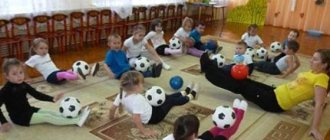What should be in a nursery group?
The configuration of the sleeping area is carried out taking into account the requirements of GOST and SanPiN, and involves equipping with the following types of furniture:
- Cribs (for babies). ...
- Beds for young children. ...
- Changing tables. ...
- Table and chair for the teacher. ...
- Linen closet.
24 Mar
2022 Interesting materials:
How to style your hair beautifully using a straightening iron? How to criticize a leader? How does a crocodile move in water? How to chop a pumpkin? How to rotate the camera in Sims 3? How to rotate an area in Photoshop? How cool is it to light a lighter? How is Easter cake connected to Easter? How do chickens start laying eggs? How to eat eggs Benedict?
Subject development environment in the first junior group in accordance with the Federal State Educational Standard
Albina Gordienko
Subject development environment in the first junior group in accordance with the Federal State Educational Standard
Subject development environment in the context of the Federal State Educational Standard in the first and junior groups
For children of this age, the main thing is to have enough space in the group to satisfy the need for physical activity. A properly organized developmental environment allows each child to find something to do, to believe in their strengths and abilities, to learn to perform the first mental operations with objects and toys , gaining sensory experience of interaction. And also the first experience of active interaction with adults and peers, understanding and appreciating their feelings and actions, and this is precisely what lies at the basis of developmental education. When creating a developmental space in a group room, we gave the leading role to play
activities in development, this in turn ensures the emotional well-being of each child, the development of his positive sense of self, and inclusion in various forms of cooperation, which are the main goals of preschool education and upbringing.
Taking into account the age characteristics of the possible achievement of a child in a group , we thought about the zoning of the group room .
For this purpose, the following centers have been formed within the group space:
Corner for girls “Little Housewives”
Corner for boys “Little Builders”, “Car Park”
Theatrical corner “Visiting a fairy tale” and “Musical shelf”
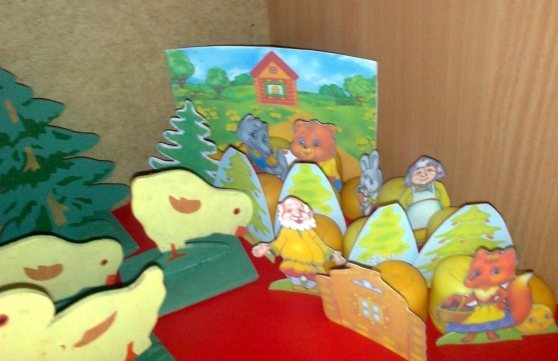
Corner of sensory and educational games "Poznavaika"
Water and Sand Center
Organization of a developing subject-spatial environment of a preschool educational institution The issue of organizing a subject-developmental environment of a preschool educational institution is particularly relevant today. This is due to the introduction of the Federal State.
Source
Subject-developmental environment in the early age group according to the Federal State Educational Standard
Svetlana Toropova
Subject-based developmental environment in the early age group according to the Federal State Educational Standard
What is a subject-developmental environment or a subject-spatial environment?
This is part of the educational environment, which is a specially organized space for preschool education. Space means premises, areas, as well as materials, equipment and supplies for the development and education of preschool children.
A developing subject-spatial environment is a set of conditions that have a direct and indirect impact on the comprehensive development of a child in kindergarten, the state of his mental and physical health, the success of his further education, as well as on the activities of all participants in the educational process in a preschool institution.
When building a subject-spatial environment, I take into account the age and individual characteristics of children’s development, focusing on the protection and promotion of the health of preschool children and in accordance with the requirements of the Federal State Educational Standard for Education.
The basis of the developmental environment in preschool education is the relationship between an adult and a child.
The teacher’s task is to develop the preschooler as a person.
Help the child feel protected, trust others and enjoy everything around him
To form the core of a child’s personal culture
Develop the individuality of a preschooler.
The developing subject-spatial environment must include components that are necessary for the physical, aesthetic, cognitive, speech and social development of children. These components make children's activities varied and interesting. Preschoolers develop both collectively and individually. A properly constructed subject-development environment ensures the socio-cultural development of a preschooler, satisfies their creative abilities and helps in the development of other abilities. Children become more capable when they continually improve their skills. A developing subject-spatial environment provides them with materials for various activities and models their spiritual and physical appearance. In a properly organized group environment, children's lives become more diverse.
According to the Federal State Educational Standard for Preschool Education, the educational program of a kindergarten must contain sections in 5 areas:
-artistic and aesthetic development
I organize the developmental environment in the group in such a way that the tasks of each educational area are viewed and solved, taking into account age and individual characteristics.
The developmental environment should shape the personal qualities of a preschooler. When building a development environment, I took into account the following principles:
The principle of distance in communication
To improve relationships with children, I conduct confidential conversations “eye to eye.” When communicating, I also take into account the fact that each person has his own ideas about a comfortable interaction distance. Some children feel better at a closer distance, others at a longer distance. But these situations may vary depending on the situation.
When planning the developmental environment, I took into account that each child could find a comfortable place in terms of their emotional state, “a corner of solitude”, “a place for joint meetings”.
Activity principle
The group organized the play space in such a way that children could be active independently or in joint activities with an adult. They could take part in outdoor games, organize role-playing games and other activities.
The principle of stability - dynamism
The principle of compensation and flexible zoning
The space in the group is organized in such a way that the children’s areas of activity do not overlap. Children in a group can simultaneously conduct different types of activities and not interfere with each other. Screens and double-sided furniture will help with this.
The principle of emotionality of the environment and individual comfort
Emotionogenicity is the ability to evoke emotions in a person and spread them.
The environment should encourage children to interact with its various elements and increase activity. It is important that children receive a variety of experiences from their surroundings.
The principle of combining familiar and extraordinary elements in the interior
At preschool age, children begin to comprehend the basics of aesthetics. It is necessary to diversify the space with sounds and color spots - this will awaken children’s taste and give them the opportunity to fantasize.
The principle of openness - closedness
The environment must be accessible and flexible for change. It should be not only developing, but also developing. The environment needs to change as children grow older, they gain more skills, and new interests appear.
The principle of taking into account gender and age differences
When creating an environment, it is necessary to take into account the gender differences of children. To give boys and girls the opportunity to demonstrate their abilities and inclinations, taking into account the accepted standards of masculinity and femininity.
The development environment must have the following qualities
The task of the developmental environment is to form the individuality of each child, taking into account his capabilities, activity and interests.
In my early age group “Fairy Tale” the following centers are designated:
One of the main objectives of this area is the development of children’s social and emotional intelligence, their emotional responsiveness, empathy, friendly communication skills and interaction with adults and peers. The main thing is that it contributes to the versatile and full development of the emotional and sensory sphere of young children as a condition for their successful and harmonious development.
Safety Center : although my kids are still very small, from an early age I introduce them with the help of games and play techniques to such concepts as “traffic lights”, traffic signals “red”, “green”, “yellow”. A “road” layout has been designed, and I also use educational posters with stickers.
Includes centers:
“Experiments”: soft pyramid, filled disks with different cereals, cotton wool, multi-colored pompoms, “fishing”, magnifying glasses, sand, dough, etc.
“Center to Know” - different types of animals, layouts: domestic animals”, “Wild animals”, “Birds”.
Games and game aids “Who eats what”, “Whose tail”, “Moms and babies”, “Who is hiding”, etc.
Area "Speech development"
Speech is at your fingertips - everyone knows this. the center for the development of fine motor skills is of great importance , which includes:
Games with cereals "pools"
Games with different types of dough
Drawing on sand, semolina
Games and aids: labyrinths, lacing, games with lids, with clothespins, busy boards.
In the book corner there are books according to the age of the children, with hard pages, music books, books with reusable stickers. To make it convenient for children to peel them off and stick the stickers back on, I made special tails.
The “Tell and Show Cube” manual can also be used for weekly themes and to introduce children to the animal world, the natural world, etc.
To diversify the subject-spatial environment of the game, game aids change in accordance with the goals and objectives, the theme of the week, and the individual and age-related needs of children. To keep children interested, some games are removed, while others update the subject-spatial environment, then taken out again and changed.
The developing subject-spatial environment in a preschool educational organization must be built in accordance with the requirements of the Federal State Educational Standard for Education. In the Federal State Educational Standard, the main thing is not the result, but the condition. This is the standard condition. Conditions are the social situation of the child’s development - the established system of interaction between the child and the outside world, represented by adults and children. And if the conditions are created, the standard is implemented.
Source
Subject-based development environment in the 1st junior group of kindergarten
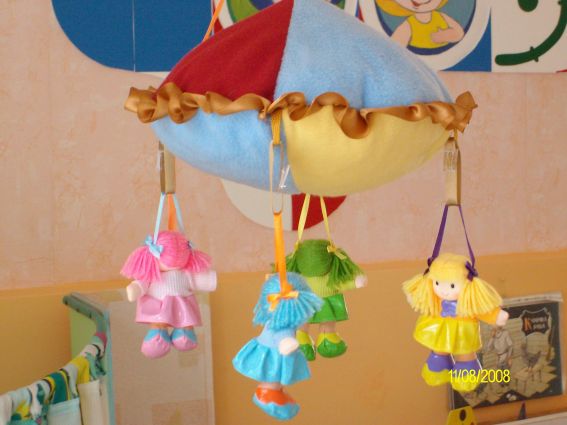
One of the determining factors in raising children is the subject-development environment. We present to your attention our version of a development environment.
All centers of the developmental environment in our group are interconnected and united by tasks implemented in the updated program edited by M.A. Vasilyeva:
During early childhood, a small person actively learns about the world around him. And our task is to make the child’s environment bright, interesting, memorable, emotional, active, and mobile. A properly organized subject-development environment helps an adult ensure the harmonious development of the child, create an emotionally positive atmosphere in the group, organize and conduct games and activities, and thus accustom children to independent games with gradually more complex content.
Physical activity zone
The need for movement is an important task when organizing a subject-development environment. The “Motor Activity Zone” has a “health track”, massage mats, balls, gymnastic sticks, hoops, throwing balls, rings, attributes for outdoor games, as well as aids necessary for morning exercises and awakening exercises - flags, rattles .
In the area of play propulsion modules, technical toys are collected: cars - dump trucks, trucks (children can easily roll dolls, soft toys in them, and transport construction parts); cars, wheelchairs, strollers. There is also play building material of different sizes in primary colors for constructing buildings and toys for playing with.
Game
The main activity of our kids is play. Ours contains toys that introduce children to the everyday objects around them. Kids not only get acquainted with objects that are new to them, but also learn to act with them. And then they transfer the acquired knowledge and skills into everyday life.
Since I am conducting experience in sensory work, in the “Living Room” there are sets of dishes in primary colors, I knitted handbags in primary colors, and in the dressing room I sewed multi-colored skirts with headbands.

helps the teacher in amateur play - experimenting with various objects and natural materials. By organizing games with sand and water, the teacher not only introduces children to the properties of various objects and materials, but also reinforces basic ideas about the shape, size, color of objects, and develops the child’s fine motor skills.
Kids love these games. Sand can be poured from palm to palm, from a scoop into a mold, you can bury various objects in it and dig them out, build slides, paths, etc. Playing with water evokes positive emotions and promotes inner relaxation of the baby. The center is located so that children can approach it from all sides.
Didactic table
The educational table is part of educational games. I use it to conduct play-activities with a small group of children and individually to develop sensory abilities. I periodically change the occupancy of the teaching table, because the equipment of the teaching table is very mobile.
We purchased collapsible chairs with tools for the group for our boys. Kids acquire certain skills when operating with screwdrivers and a hammer.
Music and Theater Center
Children are delighted with our music and theater center. There are musical instruments here that bring many joyful moments to children. And, in addition, they develop phonemic hearing and a sense of rhythm in the baby. We try to introduce children to various types of theater, so that each child can choose the theater that is closest and most convenient to him. Here we have a flannelgraph, table theater, finger theater and Bi-Ba-Bo dolls. Meeting with a doll helps children relax, relieve tension, and create a joyful atmosphere.
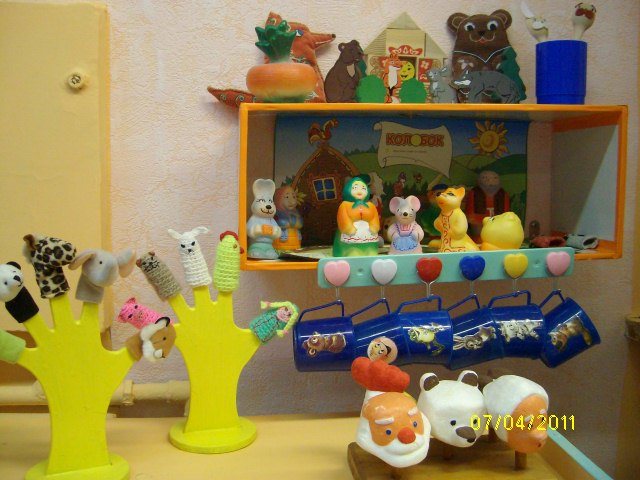
ISO corner
Early age is most favorable for the development of visual activity. Therefore, in the corner of visual arts there are markers, crayons, pencil sets, stencils, plasticine, drawing paper, gouache and brushes.
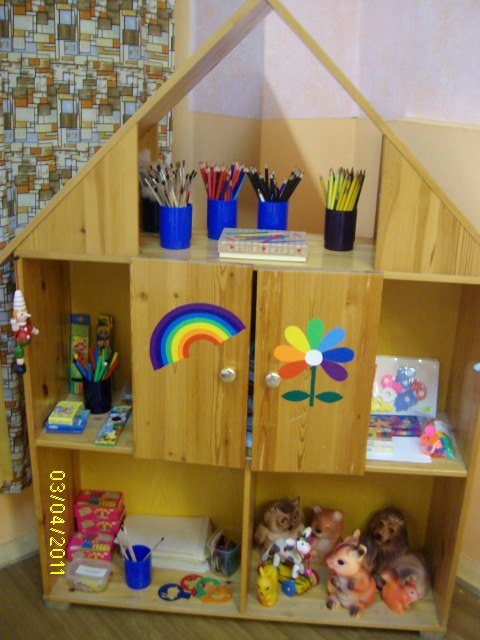
Book corner
Since the development of active speech is the main task of children’s development, sets of subject pictures, sets of plot pictures, games on cognitive development and speech development are selected in the center of a favorite book and speech development. My kids love it when we read books and look at pictures with them, so we have a lot of books here according to the program.
Corner “My Family”
At an early age, children have a hard time being separated from their parents; our common goal is to help the child enter the life of kindergarten as painlessly as possible. And together with parents, a “my family” corner was created for the kids. Parents brought their family photos, and now children can look at the photo at any time and remember mom and dad. This helps ensure that the baby does not feel lonely or abandoned. While looking at the photographs, we talk with the children, question them, activating the children’s speech.
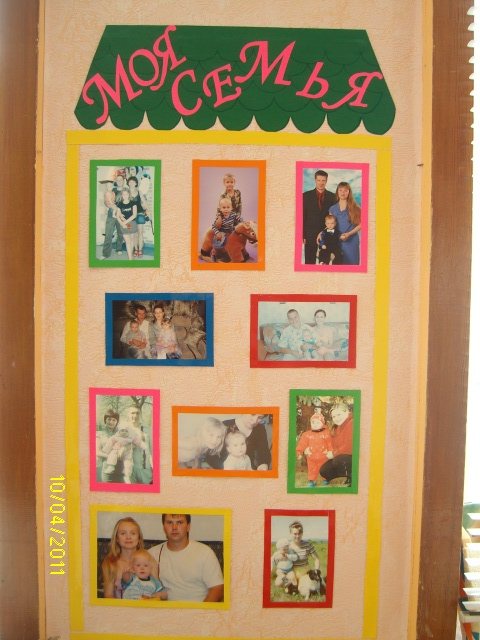
Center for educational games
The center for educational games is aimed at developing speech, sensory perception, fine motor skills, and imagination. Equipment: nesting dolls with inserts, inserts of different shapes, a set of sticks of different colors, lacing toys of different types, plot-didactic panels with buttons, buttons, different types of mosaics, lotto on different topics, printed board games, wall panel with geometric shapes.
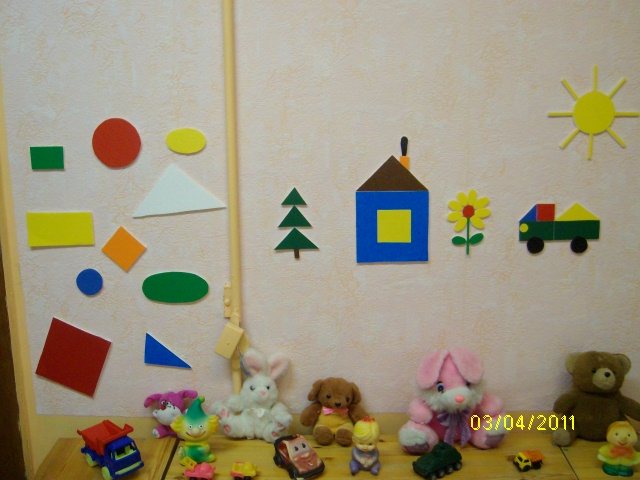
A place for privacy
Children love a corner of solitude where they can read a book alone, sit with their favorite toy and just relax.
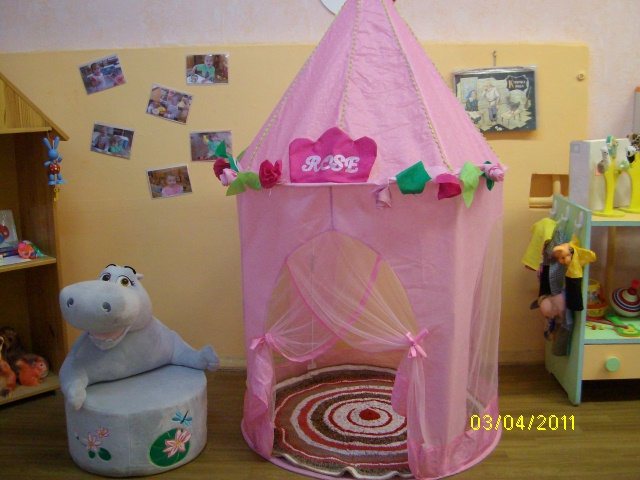
Changing room
I would like to talk a little about the design of the dressing room. There is a stand “Here we are” , where photos of children attending the group are posted. Children look at the photos and say the names of the children.
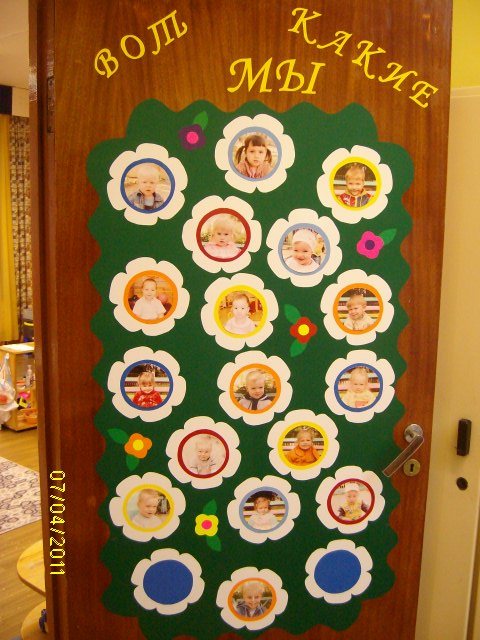
There is a corner for parents, a corner for an exhibition of children's art works, and a corner for modeling, where children's works are also exhibited.
All the toys and aids that surround the baby, to one degree or another, influence his development. All the corners presented to your attention constitute a subject-development environment.
Source

